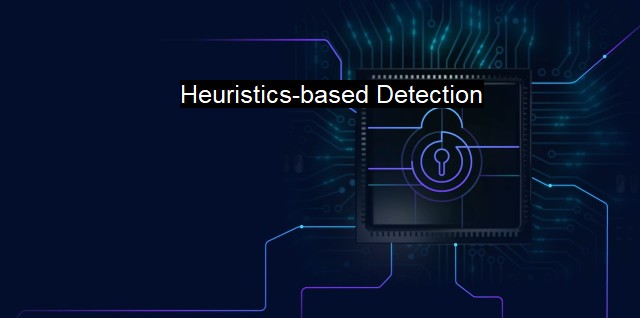What is Heuristics-based Detection?
The Power of Heuristics-based Detection in Cybersecurity: Staying Ahead of Evolving Threats
Heuristics-based detection is a proactive approach used in cybersecurity and antivirus software applications, revolving around identifying new viruses by analyzing their behaviour and using an existing rule-based algorithm. The term "heuristic" is derived from the Greek language, meaning "serving to discover," a fitting definition for what it offers in the realm of cybersecurity. It is primarily focused on keeping computer systems safe from viruses and malicious software that have not been cataloged in the databases of antivirus software.Underpinning the methodology of heuristics-based detection is the fundamental principle the approach doesn't merely rely on the existing 'signatures' - a unique set of characteristics about the known viruses to determine whether an object or software is safe. Instead, it uses algorithms based on the general behavior rules established from analyzing known viruses, to detect potential threats. This aspect significantly distinguishes it from traditional antivirus programs, which merely compare potential viruses with those previously encountered.
In many ways, employing heuristics-based detection techniques is compared to driving a car by predicting what might happen on the road - it requires the understanding and assimilation of loads of information to pre-empt troubles at the earliest possible moment. This approach targets potentially harmful files before they execute on a machine, paralleling how a vehicle’s anti-lock brakes work to anticipate an accident before it occurs.
A heuristic approach provides exhaustive structures for the construction and application of the rule base. Based on these rules, antivirus software analyzes potential security threats and detects hidden malicious behaviour. With the evolution of cybersecurity threats that are getting more sophisticated and polymorphic in nature, the heuristics-based detection techniques leverage artificial intelligence to evaluate a file based on rules established from hundreds or thousands of virus characteristics.
Despite being an advanced solution, heuristics-based detection, like any other technology, is not void of challenges. One such critical concern is the aspect of false positives where an innocent object could be incorrectly identified as a virus. The inaccuracies can sometimes be attributed to how exhaustive the heuristic measures are or the sophistication of the algorithms implemented. In a way, the higher the detection sensitivity, the higher the occurrence of false positives, a facet cybersecurity experts are continuously calibrating.
Another challenge of heuristics-based detection is labeled the problem of "false negatives," in which a virus that should be detected bypasses the system. This usually happens when the heuristic rules in place are not adequate to handle a new kind of threat. As such, it underlines the need for continuous evolution and updates of the heuristics database to improve the efficacy of detecting new threats.
Heuristics-based detection elevates the combat against cybersecurity threats by going beyond signature-based detection to proactive detection of new threats. It provides a dynamic environment to anticipate and effectively respond to evolving threats. the approach is not devoid of challenges, involving false positives and negatives. Despite these limitations though, heuristics-based detection remains a powerful approach, playing an instrumental role in consolidating the fortitude of cybersecurity in today's digitally connected era. The accompanying buzzword of AI and Machine learning promises to further improve and revolutionize how we deploy heuristics effectively. The road ahead is about striking the optimal balance between algorithm sophistication and detection rates for heuristics-based detection to thread new solutions to combat evolving threats in cybersecurity.

Heuristics-based Detection FAQs
What is heuristics-based detection in cybersecurity and antivirus?
Heuristics-based detection refers to a method of identifying potential threats by analyzing the behavior of files and programs. It involves looking for patterns and characteristics that match known malicious activities, and using these indicators to flag suspicious files or behaviors.How does heuristics-based detection differ from signature-based detection?
Signature-based detection involves comparing incoming files to a database of known threats, while heuristics-based detection seeks to identify new and unknown threats based on their behavior. This makes it a more proactive approach to threat detection and can be effective against zero-day attacks or other sophisticated threats that don't have a known signature.What are the benefits of using heuristics-based detection in antivirus software?
Using heuristics-based detection can help antivirus software catch and block new and emerging threats before they can cause harm. It can also help reduce false positives, since it looks beyond simple file signatures to evaluate the behavior of a file or program. This approach can be particularly useful in detecting malware that has been designed to evade traditional signature-based antivirus programs.Are there any limitations to heuristics-based detection?
One limitation of heuristics-based detection is that it can sometimes produce false positives, or flag legitimate files or programs as potential threats. Another challenge is that it requires substantial computing power and can be less effective against certain types of threats, such as those that use obfuscation techniques to evade detection. That said, when used in combination with other detection methods, heuristics-based approaches can be an effective tool in a comprehensive cybersecurity strategy.| | A | | | B | | | C | | | D | | | E | | | F | | | G | | | H | | | I | | | J | | | K | | | L | | | M | |
| | N | | | O | | | P | | | Q | | | R | | | S | | | T | | | U | | | V | | | W | | | X | | | Y | | | Z | |
| | 1 | | | 2 | | | 3 | | | 4 | | | 7 | | | 8 | | |||||||